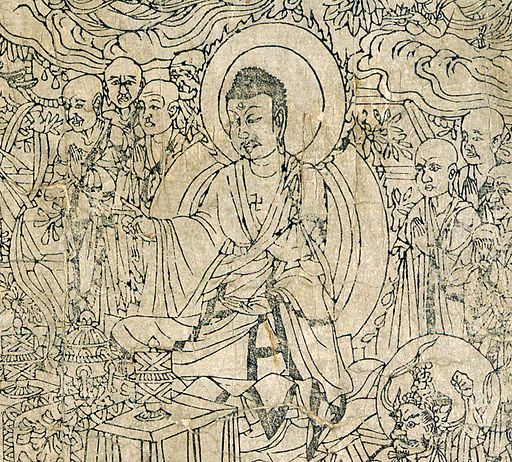 The Diamond Sutra has great historical significance even outside of Buddhism, because a translation of it is considered the oldest printed book in the world, dating from 868 A.D. (frontispiece shown to the right.) This copy was found in the Caves of the Thousand Buddhas in 1907 – themselves an amazing discovery – and is now housed in the British Library. Historians believe the first Chinese translation of the sutra occurred as early as 1200 years before even this date, around 401 C.E.
The Diamond Sutra has great historical significance even outside of Buddhism, because a translation of it is considered the oldest printed book in the world, dating from 868 A.D. (frontispiece shown to the right.) This copy was found in the Caves of the Thousand Buddhas in 1907 – themselves an amazing discovery – and is now housed in the British Library. Historians believe the first Chinese translation of the sutra occurred as early as 1200 years before even this date, around 401 C.E. The sutra begins, as many sutras do, with the phrase ‘Thus have I heard’. The elder monk Subhuti approaches the Buddha to ask,
"If sons and daughters of good families want to develop the highest, most fulfilled and awakened mind, if they wish to attain the Highest Perfect Wisdom, what should they do to help quiet their drifting minds and help subdue their craving thoughts?"
(all text from the translation by Alex Johnson available at Diamon-Sutra.com)
The Buddha initially responds with standard teachings on detachment from phenomena, and practicing charity and compassion – also without attachment to outcome. However, as the discussion with Subhuti progresses, the Buddha shifts the conversation with this question that he puts to Subhuti,
"What do you think, Subhuti, has the Buddha arrived at the highest, most fulfilled, most awakened and enlightened mind? Does the Buddha teach any teaching?"
It is here, that the conversation begins to change, and the emphasis shifts to the natural enlightenment within each of us. The Buddha makes clear that enlightenment is not a reward for good behavior or even for attaining a egoless, non-attached state. Enlightenment is a realization of one's true nature, not the memorization of teachings or the practicing of methods. As Subhuti responds to the Buddha,
"The truth in [the teachings] is uncontainable and inexpressible. It neither is, nor is it not. What does this mean? What this means is that Buddhas and disciples are not enlightened by a set method of teachings, but by an internally intuitive process which is spontaneous and is part of their own inner nature."
The sutra at this point becomes very koan-like, with statements that seemingly contradict each other on the surface level, but are designed to break any attachments a practitioner may have to ideas of the Buddha and the dharma. The Buddha talks about his own enlightenment and the teachings, and then says,
"And yet, even as I speak, Subhuti, I must take back my words as soon as they are uttered, for there are no Buddhas and there are no teachings."
The Buddha makes clear through a continuing series of exchanges along these lines that Buddhism is not the adoption of a philosophy, the worshiping of him or any other Buddha, or the ritualistic practice of meditation or any other method. These are all tools to aid one's direct realization of enlightenment. Often an attachment to the teachings, Buddha, or methods can develop along the way that actually hinders one's own realization, or generates an arrogance around oneself as a practitioner, all of which is simply further delusion.
Towards the end of the sutra, Subuti asks,
"Blessed lord, when you attained complete Enlightenment, did you feel in your mind that nothing had been acquired?"
And the Buddha replies,
"That is it exactly, Subhuti. When I attained total Enlightenment, I did not feel, as the mind feels, any arbitrary conception of spiritual truth, not even the slightest. Even the words 'total Enlightenment' are merely words, they are used merely as a figure of speech."
The Buddha concludes the Diamond Sutra with,
"Like a tiny drop of dew, or a bubble floating in a stream;
Like a flash of lightning in a summer cloud,
Or a flickering lamp, an illusion, a phantom, or a dream.
So is all conditioned existence to be seen."
Within Buddhism, the Diamond Sutra is sometimes discussed as a discourse on the difference between the arhat enlightenment of Theravada Buddhism and the Buddhahood of Mahayana. From this point of view, an arhat may maintain a subtle attachment to the dharma and enlightened states of mind, that prevents complete dissolution of selfhood. However, others read the Diamond Sutra as transcending religion altogether, by showing – or cutting through, as the title suggests – the delusion of attachment to a particular religious ideal. Direct realization is what the Buddha points to in the Diamond Sutra - not Buddhism.


